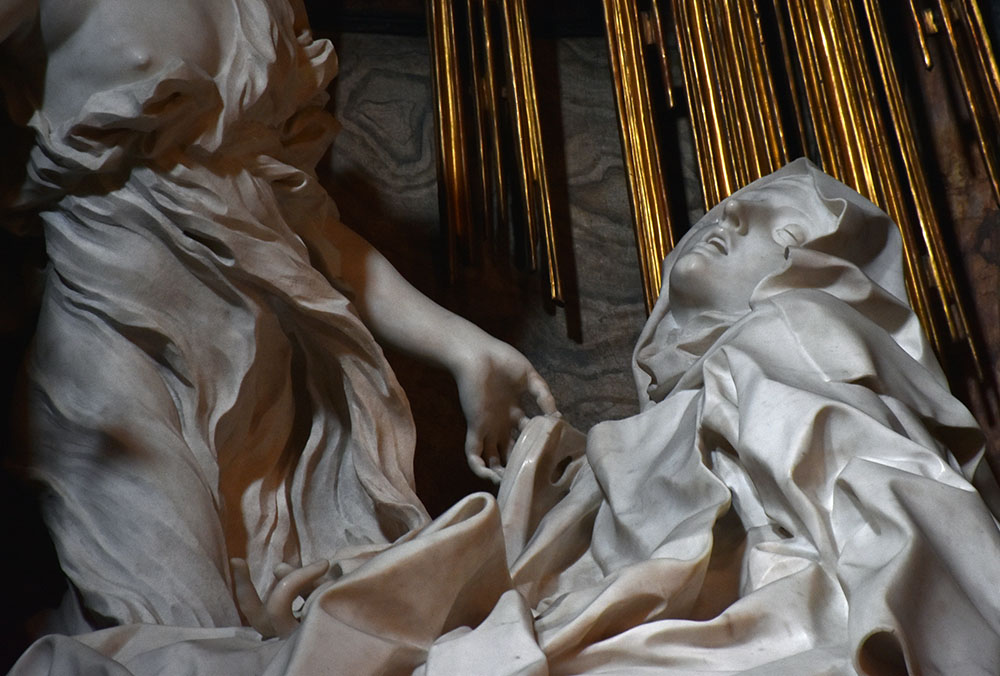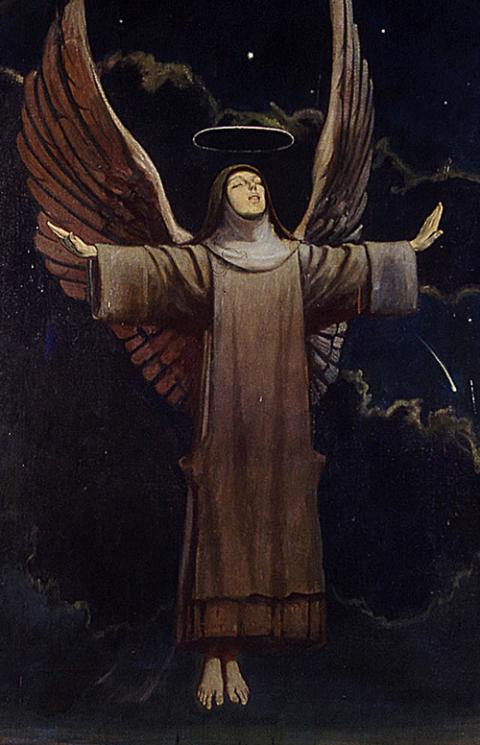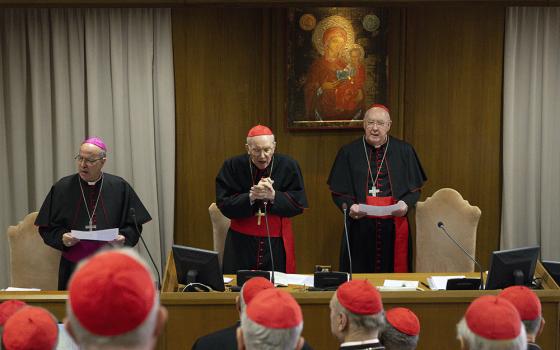
A monument to St. Teresa of Ávila is seen in Ávila, Spain. (Dreamstime/Felipe Caparros Cruz)
While in the confessional with a struggling novice in a lay consecrated community, the late Puerto Rican-born physicist, priest and writer Lorenzo Albacete recommended reading St. Teresa of Ávila's autobiography as penance.
When the young novice came upon the sections about Teresa's mystical episodes, she "got really scared," saying to Albacete, "This woman is kind of crazy! She's talking to Jesus, Jesus tells her what to do, she does it. ... How does the church know that she was just not crazy? Out of all the crazy people throughout history that have claimed to talk to Jesus, how do you know the true one?"
"Your problem," Albacete responded, "is that you think that crazy has nothing to do with Christ — that it's an objection."
"If Christ cannot win over crazy," he continued, "then there is a space of the experience of humanity that he cannot conquer and win over. So sanctity and crazy are not mutually exclusive. For all we know she could have been crazy, because Jesus can use a certain state of mind to get into a relationship with you. So she might have been crazy, who cares?"
Talk about mental health is becoming more and more ubiquitous these days. The stigma toward mental illness is being challenged by doctors and educators, popular entertainers and social media personalities, in the name of transparency, authenticity and self-care.
But where exactly does one draw the line between reasonableness and madness? And further, where do these categories come from, and how have they shifted over time? My readings of mystical saints like Teresa and more contemporary writers like the French philosopher Michel Foucault have propelled me to delve more deeply into these questions.

Detail of "The Ecstasy of St. Teresa" (1646) by Gian Lorenzo Bernini, in Santa Maria della Vittoria Church in Rome (Wikimedia Commons/Vassil)
In his 1961 book Madness and Civilization, Foucault explores the changing attitudes toward "madness" from the Middle Ages to the dawn of modernity. He draws a correlation between the Enlightenment concept of "pure reason" and the medicalization of madness, juxtaposing it with contrasting attitudes during medieval times.
Foucault dedicates a significant portion of his work to the role of the "passions." Before the Enlightenment, the passions were understood to be subject to perversion by original sin. But through mortification and growth in virtue, those same passions can be transformed into tools of sanctity, charity and communion.
Rationalism set reason in opposition to the passions, deeming them to be something to be controlled and, when possible, eliminated rather than integrated.
We can see how this modern attitude toward reason has inspired accusations of hysteria and lunacy toward some of the most passionate medieval saints. One of the most popular is that of Teresa of Ávila. As early as 1883, scientists and psychologists have claimed that the saint's ecstatic visions and use of erotic, spousal imagery in her writings were not in fact true mystical experiences of God's love. Rather, they were hysterical hallucinatory fits brought on by sexual repression.

Angela of Foligno, depicted in a 17th-century illustration (Wikimedia Commons)
Similar claims have been made about Angela of Foligno, the 13th-century Franciscan nun who after her first experience of being "possessed" with Christ's love threw herself to the ground in the middle of a street screaming, "Love still unknown, why? Why? Why?"
On one hand, we ought to question the extent to which the diagnosis of hysteria was born of a positivistic, patriarchal medical discourse that looked down upon what Cristina Mazzoni in her book Saint Hysteria: Neurosis, Mysticism, and Gender in European Culture calls the "religious-feminine element."
On the other hand, these accusations of hysteria born of repression make sense. Women like Teresa and Angela lived "worldly" lives before vowing themselves to chastity and poverty. Teresa was born in a wealthy family. As a teen, she fixated on fashion and her public image, and devoured romance novels, fantasizing about being swept off her feet by her own prince charming.
Her obsessions oscillated between her vain attachments and the allure of sanctity, going as far as running away from home when she was 7 years old to be martyred by the Moors. After entering the convent, she dwelled on her "wickedness" and sinful tendencies, at times referring to herself as a "filthy worm."
Angela also lived a life of comfort before giving up her wealth and joining the Franciscans. Married with children, she "loved the world and its pleasures," and eventually fell into a life of sin and debauchery. After her dramatic conversion and divestment of wealth, she practiced extreme forms of penance and reported numerous mystical visions.
If Teresa's and Angela's stories aren't enough to get you questioning the dividing line between reasonableness and madness, take the story of the patron saint of mental illness. St. Christina the Astonishing was born in Belgium in the mid-12th century. After her parents died, she worked as a shepherdess and suffered from intense seizures, dying in her early 20s. During her funeral, she came back to life and floated from her casket to the rafters, claiming that she couldn't stand the stench of the congregation's sins.

A painting in a church depicts St. Christina the Astonishing. (Wikimedia Commons/Patrick3Lopez)
After having a vision of the souls suffering in purgatory, God gave her the option to go straight to heaven or to continue living a life of penance for the souls in purgatory. She chose to stay on earth.
Her penances were extreme, to say the least. She was seen walking through fire pits, drowning herself in a lake, and allowing herself to be mauled by dogs ... from which she sustained minimal injuries. Some thought she was insane (including modern claims of hysteria) while others thought she was possessed by a demon. But the accounts of laypeople and clerics (including St. Robert Bellarmine) were enough for her to be considered a true saint.
Perhaps these women's passionate spiritual lives and out-of-body experiences were caused by mental instability and repressed sexuality. But even if these women were indeed "mad," would that preclude the possibility of the Divine communicating to and working through them?
For me, this question about God's ability to work with "madness" is not just a theological exercise — it's a deeply personal one. Reflecting on the stories of these mystical saints has enabled me to delve deeper into the story of my maternal grandmother, who immigrated to Newark, New Jersey, from Greece in 1956 and married my grandfather five years later at the age of 25.
It wasn't until she gave birth to my mother that her mental health struggles became noticeable. While my grandmother was giving birth, her doctor mangled her uterus with forceps, causing her to bleed profusely. The doctor determined "there was nothing [he] could do," and left her to bleed to death (he eventually lost his license for malpractice).
As she was bleeding, the Virgin Mary appeared to her, telling her that another doctor would come shortly and save her life. Sure enough, another doctor was passing through the hallway and happened to hear my grandmother moaning in agony. He asked one of the nurses to see her file, and wondered why she had been left to die when all she needed were a few stitches.
Soon enough, my grandparents were home with my mother in one piece. But after a few days getting settled into life at home with a newborn baby, my grandmother started screaming about someone coming after her to attack the baby, and became so erratic that she threw a glass of orange juice against the kitchen wall. Along with these details in the psychiatrist's report (which I discovered in my grandparent's basement 50 years later) were more claims about visits from "the Madonna."
My grandmother's paranoid schizophrenia improved over the years with the help of heavy medications and regular visits to a psychiatrist. She had moments of paranoia, which flared up more intensely after traumatic experiences, but rarely claimed to have any visual or auditory hallucinations.
Advertisement
Though her level of piety may never have reached that of mystics like Teresa of Ávila, she attended church services regularly and prayed in front of the many Marian icons hanging throughout the house. When she felt stressed or worried, she would spend extended periods of time crossing herself repeatedly in front of an icon of Mary.
My grandmother's diagnosis was real. She heard people talking who were not actually there, and her fears about catastrophic events like the house burning down or women at church trying to sabotage her had little to no basis in reality. But does her mental instability indicate that her relationship with Mary was merely imagined?
All of this research into the lives of the saints and of my own family members brought me back to that dialogue between Albacete and the young novice. It forced me to face that question of whether or not mental illness could impose a limitation on a God whose power and love are limitless.
What I found is that, as much as mental instability ought to be recognized and treated for what it is, God can indeed work through and use us as we are, before we even get around to seeking healing or treatment.
As we continue treating and destigmatizing mental health issues, let's ask for the intercession of those holy figures whose experiences were written off because of their "madness." Their witness reminds us to never underestimate the infinite creativity of God, who can make a masterpiece out of what the world deems to be a mess.






